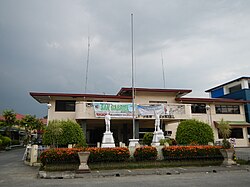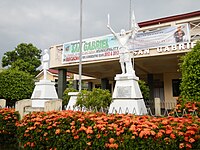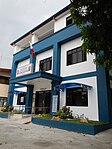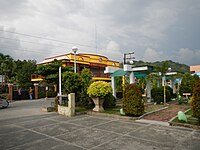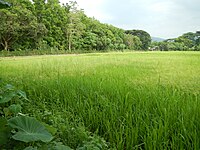San Gabriel, La Union
This article needs additional citations for verification. (August 2013) |
San Gabriel
Baka-Burnotan | |
|---|---|
| Municipality of San Gabriel | |
San Gabriel River Basin & Municipal Hall | |
| Nickname(s): The Softbroom Capital of the North; Highland Vegetable and Tourism Adventure Paradise of La Union | |
| Motto(s): San Gabriel, Mapangnamnamaan | |
| Anthem: San Gabriel Hymn | |
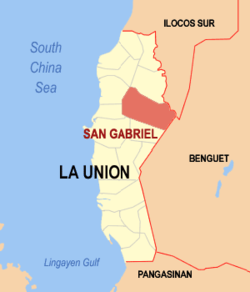 Map of La Union with San Gabriel highlighted | |
Location within the Philippines | |
| Coordinates: 16°40′N 120°24′E / 16.67°N 120.4°E | |
| Country | Philippines |
| Region | Ilocos Region |
| Province | La Union |
| District | 1st district |
| Founded | 1947 |
| Named for | Saint Gabriel |
| Barangays | 15 (see Barangays) |
| Government | |
| • Type | Sangguniang Bayan |
| • Mayor | Lany B. Carbonell |
| • Vice Mayor | Ramolito A. Guinomma |
| • Representative | Francisco Paolo P. Ortega V |
| • Municipal Council | Members |
| • Electorate | 13,202 voters (2022) |
| Area | |
• Total | 129.87 km2 (50.14 sq mi) |
| Elevation | 150 m (490 ft) |
| Highest elevation | 635 m (2,083 ft) |
| Lowest elevation | 5 m (16 ft) |
| Population (2020 census)[4] | |
• Total | 18,943 |
| • Density | 150/km2 (380/sq mi) |
| • Households | 4,381 |
| Economy | |
| • Income class | 4th municipal income class |
| • Poverty incidence | 13.52 |
| • Revenue | ₱ 115.7 million (2020) |
| • Assets | ₱ 395.7 million (2020) |
| • Expenditure | ₱ 121.2 million (2020) |
| • Liabilities | ₱ 55.76 million (2020) |
| Service provider | |
| • Electricity | La Union Electric Cooperative (LUELCO) |
| Time zone | UTC+8 (PST) |
| ZIP code | 2513 |
| PSGC | |
| IDD : area code | +63 (0)72 |
| Native languages | Ilocano Tagalog |
| Website | https://www.sangabriellaunion.gov.ph/government |
San Gabriel , officially the Municipality of San Gabriel (Ilocano: Ili ti San Gabriel; Filipino: Bayan ng San Gabriel), is a landlocked municipality in the province of La Union, Philippines. According to the 2020 census, it has a population of 18,943 people.[4]
Etymology
[edit]
The name of the town is derived from its patron saint, Gabriel, one of the archangels in Christian, Jewish, and Islamic traditions, known as a messenger of God. Towns were often named after saints to signify spiritual protection and religious devotion, and the choice of Saint Gabriel likely reflects the community's faith or a historical connection, such as the founding of a church or a significant event attributed to his intercession.
History
[edit]San Gabriel traces its origins to a settlement of the Kankanaey people, one of the indigenous groups of the Cordillera region. When Spanish colonizers arrived, the Augustinian friars established it as a sitio (small settlement). During the Spanish colonial era, this sitio was part of the administrative division known as Amburayan.[6]
The settlement was initially known as “Baka Burnotan,” a name derived from local traditions. The term refers to the game “binnornutan” or tug-of-war, which locals played while grazing their “baka” (Philippine buffalo). These games were often held between the Igorots, predominantly from the Kankanaey tribe who migrated from the Mountain Province to escape tribal conflicts, and Christian settlers from the lowlands. Due to their resilience and hard work in the mountains, the Kankanaey participants often emerged victorious in these contests. Over time, the name "Baka Burnotan" was shortened to Burnotan.[6][7]
The sitio’s location, characterized by a wide plain suitable for animal grazing and farming, as well as a nearby river for irrigation, made it an ideal place for settlement.[6]
In the 1880s, a Spanish priest named Fr. Redondo conducted an ocular visit to the area. Recognizing the need for evangelization, Fr. Redondo constructed a small church made of cogon grass and began preaching to the residents. His efforts, in partnership with the local community, led to the baptism and conversion of many pagan inhabitants to Christianity. On April 20, 1896, Fr. Redondo introduced the image of Saint Gabriel the Archangel as the patron saint of the settlement. A year later, on April 19, 1897, the sitio was officially renamed San Gabriel in honor of its patron.[6]
On May 28, 1902, Act No. 410 of the Philippine Commission created the Lepanto-Bontoc Province, which included Amburayan as one of its sub-provinces. Consequently, San Gabriel became part of this administrative structure. On the same day, Act No. 411 mandated the establishment of local civil governments in the province. Indigenous settlers, referred to as “non-Christian tribes” in official documents, were integrated into municipal governance, with local leaders appointed to oversee their communities. In 1906, San Gabriel conducted its first election, with Don Pablo Waggay elected as the first Township President.[6]
The administrative boundaries shifted again on August 18, 1908, with the issuance of Act No. 1876, which dissolved the Lepanto-Bontoc Province and created the Mountain Province. San Gabriel, as part of the sub-province of Amburayan, became part of this new province.[6]
In 1920, San Gabriel was designated as a Municipal District. Following the resolution of a boundary dispute between La Union and the Mountain Province, Act No. 2877 was issued on February 4, 1920, modifying and establishing the boundary line. In 1922, San Gabriel officially became a municipality of La Union.[8]
During World War II, the vast mountainous areas of San Gabriel became a refuge for people from the Mountain Province and the Ilocos Region. Much of the land in the area was owned by Ama Ontoc, a respected and influential local leader. Upon his death, the settlement was named Amontoc in his honor, a combination of his title "Ama" and his name "Ontoc."[9]
The community grew as families settled in the area, and Amontoc became a barangay (village) of San Gabriel. The first recognized leaders of Amontoc were Teniente del Barrio Lakay Madan (Madan Salungkit), followed by Lakay Oseng (Pedro Oseng) and Lakay Doro (Doro Tagatag). These leaders played significant roles during World War II, resisting Japanese invaders. Amontoc was officially recognized as a barangay of San Gabriel in 1992.[9]
Through Executive Order No. 72 issued on July 30, 1947, by President Manuel Roxas, San Gabriel was reaffirmed as one of the 17 municipalities of La Union. This order was sponsored by then-Speaker Pro-Tempore Francisco Ortega and aligned with the Revised Administrative Code of 1917.[7]
Today, San Gabriel stands as a municipality with a rich history of cultural integration, resilience, and adaptation to changing political landscapes. Its roots as a Kankanaey settlement and its evolution under Spanish and American rule are central to its identity, making it a significant part of La Union's history.[10]
Geography
[edit]
San Gabriel is recognized as the largest municipality by land area in La Union. It lies 17 kilometers (11 miles) from the provincial capital, the City of San Fernando, and 286 kilometers (178 miles) from Manila. The town’s topography is predominantly mountainous, gradually ascending eastward, with a mix of scrubland, grassland, and wetland ecosystems. Its landscape is traversed by the Baroro River, the town's major waterway, which also features the renowned Tangadan Falls, a popular tourist destination.

The municipality is landlocked and bordered by various neighboring towns. To the north, it shares a boundary with Santol, marked by an imaginary line beginning in Ticor and following the course of the Malanas River. On the eastern side, San Gabriel is bounded by Kapangan in the province of Benguet, with the border defined by an imaginary line starting from the Bacawayan River Junction, running southward along a creek, and extending to the Cabassitan River near Barangay Duplas of San Juan.
To the west, it is bordered by Bacnotan, with the boundary extending from Sitio Bato to a point in Lacong and then continuing along a straight imaginary line to Ticor, located north of Sitio Matagectec in Barangay Lacong. To the south, it shares a border with Bagulin, while the southwest boundary is marked by San Juan. The southwestern border begins at Duplas, follows the Cabassitan River westward to a concrete monument near Alangigan, and then proceeds northwest along an imaginary line to Sitio Bato, crossing the Dayacos River.
Barangays
[edit]San Gabriel is politically subdivided into 15 barangays. [11] Each barangay consists of puroks and some have sitios.
- Amontoc
- Apayao
- Balbalayang
- Bayabas
- Bucao
- Bumbuneg
- Daking
- Lacong
- Lipay Este
- Lipay Norte
- Lipay Proper
- Lipay Sur
- Lon-oy
- Poblacion
- Polipol
Climate
[edit]| Climate data for San Gabriel, La Union | |||||||||||||
|---|---|---|---|---|---|---|---|---|---|---|---|---|---|
| Month | Jan | Feb | Mar | Apr | May | Jun | Jul | Aug | Sep | Oct | Nov | Dec | Year |
| Mean daily maximum °C (°F) | 30 (86) |
31 (88) |
32 (90) |
33 (91) |
32 (90) |
31 (88) |
30 (86) |
30 (86) |
30 (86) |
31 (88) |
31 (88) |
31 (88) |
31 (88) |
| Mean daily minimum °C (°F) | 21 (70) |
22 (72) |
23 (73) |
25 (77) |
26 (79) |
26 (79) |
25 (77) |
25 (77) |
25 (77) |
24 (75) |
23 (73) |
22 (72) |
24 (75) |
| Average precipitation mm (inches) | 42 (1.7) |
48 (1.9) |
74 (2.9) |
110 (4.3) |
269 (10.6) |
275 (10.8) |
362 (14.3) |
325 (12.8) |
330 (13.0) |
306 (12.0) |
126 (5.0) |
61 (2.4) |
2,328 (91.7) |
| Average rainy days | 11.2 | 12.0 | 17.1 | 21.2 | 27.1 | 26.8 | 28.1 | 27.0 | 26.0 | 24.5 | 17.7 | 12.4 | 251.1 |
| Source: Meteoblue[12] | |||||||||||||
Demographics
[edit]| Year | Pop. | ±% p.a. |
|---|---|---|
| 1918 | 3,485 | — |
| 1939 | 5,293 | +2.01% |
| 1948 | 5,805 | +1.03% |
| 1960 | 7,546 | +2.21% |
| 1970 | 8,527 | +1.23% |
| 1975 | 9,808 | +2.85% |
| 1980 | 10,248 | +0.88% |
| 1990 | 12,532 | +2.03% |
| 1995 | 13,489 | +1.39% |
| 2000 | 14,909 | +2.17% |
| 2007 | 15,803 | +0.81% |
| 2010 | 16,628 | +1.87% |
| 2015 | 18,172 | +1.71% |
| 2020 | 18,943 | +0.82% |
| Source: Philippine Statistics Authority[13][14][15][16] | ||
In the 2020 census, the population of San Gabriel, La Union, was 18,943 people,[4] with a density of 150 inhabitants per square kilometre or 390 inhabitants per square mile.
Economy
[edit]Poverty incidence of San Gabriel
10
20
30
40
2006
39.90 2009
29.65 2012
15.02 2015
15.08 2018
5.79 2021
13.52 Source: Philippine Statistics Authority[17][18][19][20][21][22][23][24] |
San Gabriel is an agricultural town. In its early days, the people of San Gabriel were engaged mainly in highland farming as their means of livelihood. They produced rice, corn, sweet potatoes, and other root crops. As years passed, crop production decreased due to massive soil erosion in the uplands. Nevertheless, the inhabitants decided to improve their farming techniques and started making terraces. The perseverance of the people in constructing rice terraces and irrigation system along the hills and mountains of San Gabriel caused agricultural productivity to rebound.
Bananas and tiger grass ("Thysanolaena maxina") are also abundant in San Gabriel, which harvests materials for soft broom production on a weekly basis.
Government
[edit]Local government
[edit]San Gabriel, belonging to the first congressional district of the province of La Union, is governed by a mayor designated as its local chief executive and by a municipal council as its legislative body in accordance with the Local Government Code. The mayor, vice mayor, and the councilors are elected directly by the people through an election which is being held every three years.
Elected officials
[edit]| Position | Name |
|---|---|
| Congressman | Francisco Paolo P. Ortega V |
| Mayor | Lany B. Carbonell |
| Vice-Mayor | Ramolito A. Guinomma |
| Councilors | Mario P. Aligo |
| Jerry T. Fernandez | |
| Geoffrey D. Awingan | |
| Mardo A. Bang-oa | |
| Isagani L. Dumaoang | |
| Mauricio P. Canutab | |
| Dominador P. Abuan | |
| Danilo A. Elias JR. |
Tourism
[edit]- Gumayenggeng Falls at Barangay Lipay
- Katebbegan Fall at Barangay Lipay Proper
- Bakes Falls and Lon-oy Spring at Barangay Lon-oy
- Lineng Pool at Poblacion
- Tinnag-Americano Falls at Barangay Polipol
- Tangadan Falls located at Barangay Amontoc[26]
Education
[edit]High schools
[edit]The town has 4 Public High Schools and 1 Private School.
- Saint Gabriel the Archangel High School, former (San Gabriel Academy) is the only private school secondary in the municipality, a Christian School that demands love and discipline from all who join the SGA High School Family.
- Balbalayang National High School
- Lipay Integrated School
- San Gabriel Senior High School
- San Gabriel Vocational High School
Gallery
[edit]-
Municipal hall
-
Police station
-
Town center
-
Rural landscape
References
[edit]- ^ "Municipal Officials".
- ^ Municipality of San Gabriel | (DILG)
- ^ "2015 Census of Population, Report No. 3 – Population, Land Area, and Population Density" (PDF). Philippine Statistics Authority. Quezon City, Philippines. August 2016. ISSN 0117-1453. Archived (PDF) from the original on 25 May 2021. Retrieved 16 July 2021.
- ^ a b c Census of Population (2020). "Region I (Ilocos Region)". Total Population by Province, City, Municipality and Barangay. Philippine Statistics Authority. Retrieved 8 July 2021.
- ^ "PSA Releases the 2021 City and Municipal Level Poverty Estimates". Philippine Statistics Authority. 2 April 2024. Retrieved 28 April 2024.
- ^ a b c d e f "History of San Gabriel, La Union". Official Website of the Municipality of San Gabriel. Retrieved 29 December 2024.
- ^ a b "Municipality of San Gabriel". Provincial Government of La Union: Official Website. Retrieved 5 January 2015.
- ^ "Executive Order No. 72, s. 1947". Official Gazette (Philippines). Government of the Philippines. 30 July 1947. Retrieved 20 March 2023.
- ^ a b "History of Amontoc". Official Website of the Municipality of San Gabriel. Retrieved 29 December 2024.
- ^ "Executive Summary (2013)" (PDF). Commission on Audit. Government of the Philippines. 2013. Retrieved 20 March 2023.
- ^ "Province: La Union". PSGC Interactive. Quezon City, Philippines: Philippine Statistics Authority. Retrieved 12 November 2016.
- ^ "San Gabriel: Average Temperatures and Rainfall". Meteoblue. Retrieved 26 April 2020.
- ^ Census of Population (2015). "Region I (Ilocos Region)". Total Population by Province, City, Municipality and Barangay. Philippine Statistics Authority. Retrieved 20 June 2016.
- ^ Census of Population and Housing (2010). "Region I (Ilocos Region)" (PDF). Total Population by Province, City, Municipality and Barangay. National Statistics Office. Retrieved 29 June 2016.
- ^ Censuses of Population (1903–2007). "Region I (Ilocos Region)". Table 1. Population Enumerated in Various Censuses by Province/Highly Urbanized City: 1903 to 2007. National Statistics Office.
- ^ "Province of La Union". Municipality Population Data. Local Water Utilities Administration Research Division. Retrieved 17 December 2016.
- ^ "Poverty incidence (PI):". Philippine Statistics Authority. Retrieved 28 December 2020.
- ^ "Estimation of Local Poverty in the Philippines" (PDF). Philippine Statistics Authority. 29 November 2005.
- ^ "2003 City and Municipal Level Poverty Estimates" (PDF). Philippine Statistics Authority. 23 March 2009.
- ^ "City and Municipal Level Poverty Estimates; 2006 and 2009" (PDF). Philippine Statistics Authority. 3 August 2012.
- ^ "2012 Municipal and City Level Poverty Estimates" (PDF). Philippine Statistics Authority. 31 May 2016.
- ^ "Municipal and City Level Small Area Poverty Estimates; 2009, 2012 and 2015". Philippine Statistics Authority. 10 July 2019.
- ^ "PSA Releases the 2018 Municipal and City Level Poverty Estimates". Philippine Statistics Authority. 15 December 2021. Retrieved 22 January 2022.
- ^ "PSA Releases the 2021 City and Municipal Level Poverty Estimates". Philippine Statistics Authority. 2 April 2024. Retrieved 28 April 2024.
- ^ "2019 National and Local Elections" (PDF). Commission on Elections. Retrieved 6 March 2022.
- ^ "Tangadan Falls" (JPG). i.ytimg.com. La Union. Archived from the original on 22 April 2023. Retrieved 10 June 2023.


